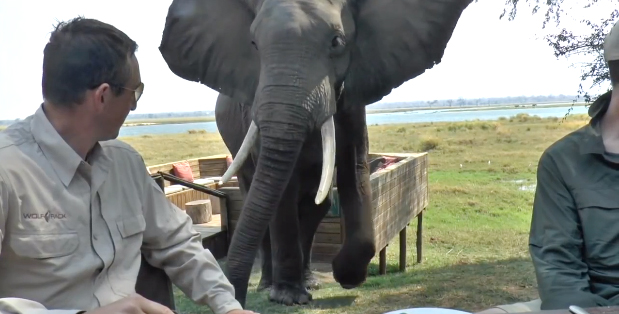Decoding An Elephant’s Trunk-Slap In Viral Video
A gifted elephant expert gives us a play-by-play of that YouTube video showing an elephant shoving tourists in Zimbabwe.
By Vicki Croke

He could easily have killed, but it seems that this young bull elephant really didn’t want to hurt anyone, the experts say.
The video from Sept. 4 made a sensation this week: An elephant in Zimbabwe’s Mana Pools National Park stands behind some tourists seated at an outdoor table. As the people try not to look back in his direction, the elephant advances, ears now spread out like wings, trunk flying forward. Humans and cutlery are tossed around a bit. Nervous laughter follows. And the elephant walks away.
Considering that an African elephant’s trunk contains at least 50,000 muscles and can weigh as much as a man, and that these creatures can easily squash a human with their heads, or effortlessly run tusks right through us, the elephant seemed restrained. Polite even.
I mean, consider the famous elephant guru Daphne Sheldrick, the woman who for decades has saved orphaned baby elephants. She once walked up to a wild elephant she thought she knew, and was promptly hurled through the air, her leg shattered.
So, why didn’t the elephant in this week’s video go that far, or kill anyone? And what was the elephant thinking and communicating?

The pivotal moment: It seems the real trouble started when this man looked back directly at the elephant.
We went to the experts, among them, one of the world’s leading authorities on elephant behavior and body languagt. After viewing the YouTube video, Dr. Caitlin O’Connell, a faculty member at Stanford, who has spent 20 years observing elephants at Etosha National Park in Namibia, gave us her vivid play by play.
First, she says, “He is a sweet and confused young male elephant and these men are very lucky to be alive!†Dr. O’Connell knows all things elephant, and specializes in male elephant culture, having written the incredible “Elephant Don: The Politics of a Pachyderm Posse.â€
Though she cautioned that there’s a lot we can’t know from the video—like what’s this elephant’s history? What’s his experience with that tourist area?—she decodes the action, practically mind-reading this bull:
From the start, here’s what she notices—the elephant, who appears to be in his early or mid-twenties (she says his tusks are big, but his face isn’t very broad), is pulling at some grass, but he’s not really eating it. That’s an important detail.
He is showing his uncertainty with a behavior called “false feedingâ€â€”here, he just snatches at grass while he watches the guests, Dr. O’Connell says. “It’s a sign of agitation and wanting people to back off.â€
Video courtesy of knockbaun/YouTube.
But the tourists don’t retreat. They don’t “give him space,†Dr. O’Connell says, by crawling under the table or moving to the side.
Then, one man actually turns a bit and looks at the elephant.
This seems to be a pivotal moment. The one Dr. O’Connell says seems to trigger the action.
“As soon as the man turns around and looks at him,†Dr. O’Connell says, “its as if that is an affront and the bull is a little too close to back out of the situation so he mock charges. And then because he’s so close when he mock charges, it seems as if he still feels threatened by how close the men are so he gives them a shove.â€
Also on The Wild Life:
Bucking The Trend: Uganda’s Elephants On The Rise
Elephant Orphan Returns To Caretakers To Give Birth
And here comes the answer, in part, to why the incident didn’t turn lethal: “Because he [the elephant] is somewhat timid,†Dr. O’Connell says, “it seems as if he didn’t really want to hurt anyone but felt cornered and confused and defended himself.â€
Everyone agrees—the people in the video were lucky. Each elephant is an individual, most are not looking for trouble, and this one was pretty nice.
“Yeah, that was an annoyed but rather patient elephant,†says Dr. William Langbauer, who has studied African elephants for decades. He says that if the elephant “had wanted them dead,†the elephant would have killed them.
And Dr. Michael Hutchins, director of conservation and science for World Safaris, says what he sees in the video is “an incredibly dangerous situation.†He points out that elephants are individuals and without knowing that particular elephant and his history, it would be impossible to predict behavior in close quarters, especially in places where elephants aren’t accustomed to seeing tourists outside of their vehicles. But, Hutchins, who leads trips to Africa himself, says, “You’ve got to be completely aware of your surroundings when you’re in the savannah like that.”

2 Responses to “Decoding An Elephant’s Trunk-Slap In Viral Video”
Hello,
I am originally from Zimbabwe know this place well. The problem here is they are feeding this elephant on that structure. The elephant is not picking up grass. they have thrown it something from the kitchen. I read this on a Zimbabwe news site
The safari operators here are playing a dangerous game. This elephant gets annoyed when there is no more feed – I don’t blame him. Yes he is a very nice elephant- Familiarity breeds contempt. Elephants killing or maiming tourists in Zimbabwe is at least an annual event
Best regards
Chris
Retired wildlife guide
Hi Chris,
Thanks for sharing this detail. I hadn’t known about the lodge feeding this elephant. That explains a lot! Feeding wildlife under any circumstances is like putting a target on their heads. Something bad is bound to happen to this poor elephant or lodge guests, with most likely lethal consequences. Very irresponsible!
Comments are closed.